Discrimination and International Human Rights: A Comprehensive Essay
VerifiedAdded on 2021/02/22
|6
|1536
|71
Essay
AI Summary
This essay provides a comprehensive overview of the breach of international human rights, specifically focusing on discrimination. It defines human rights and international human rights law, emphasizing the importance of equal treatment and the legal consequences of discrimination. The essay explores various forms of discrimination at an international level, including racial, gender, and nationality-based discrimination, providing real-world examples. It analyzes the impacts of discrimination on individuals and groups, such as decreased self-esteem and limited opportunities. Finally, it examines responses to breaches, including media exposure, increased awareness, and organizational efforts to prevent discrimination. The essay concludes by reiterating the significance of promoting and fostering international human rights to protect individuals and groups from discriminatory practices.
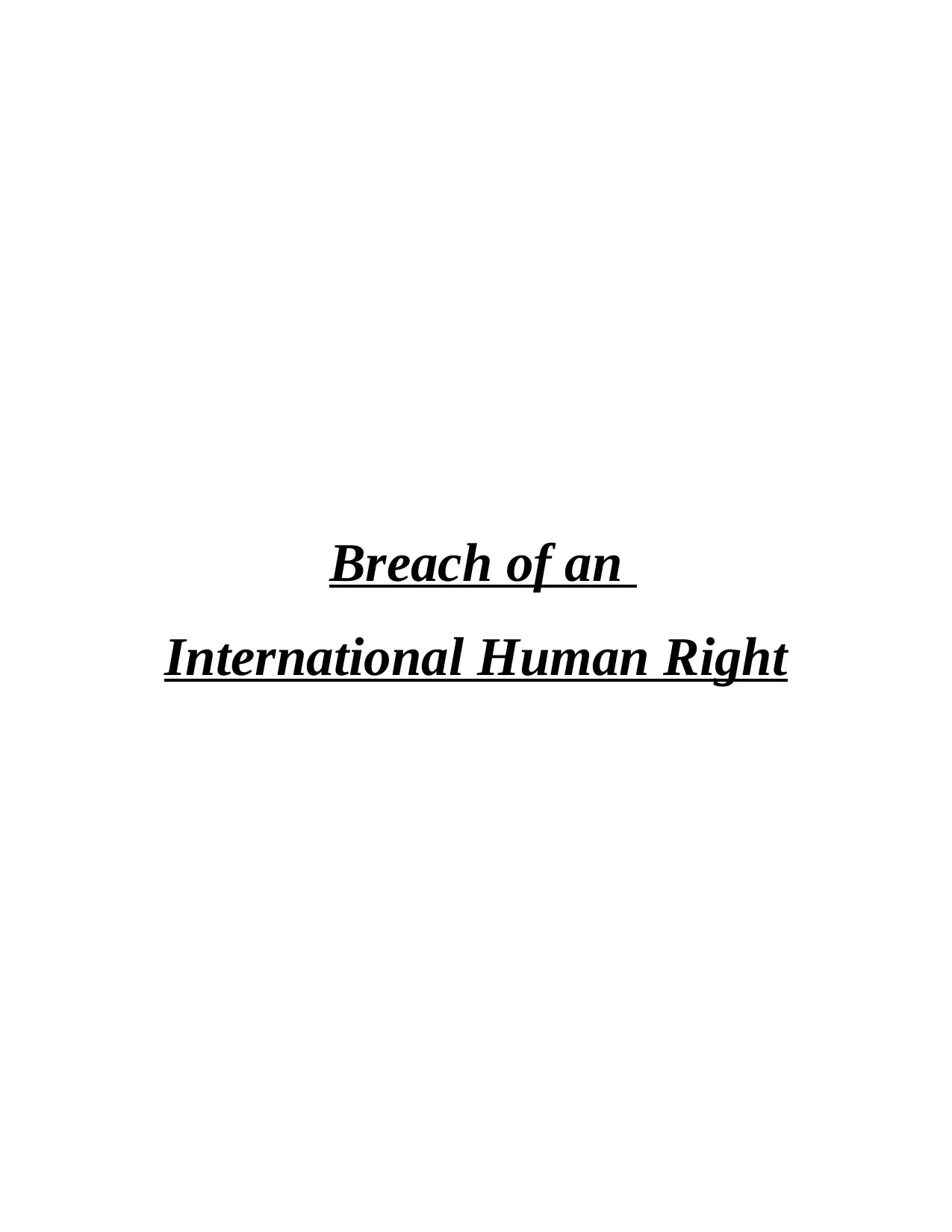
Breach of an
International Human Right
International Human Right
Paraphrase This Document
Need a fresh take? Get an instant paraphrase of this document with our AI Paraphraser
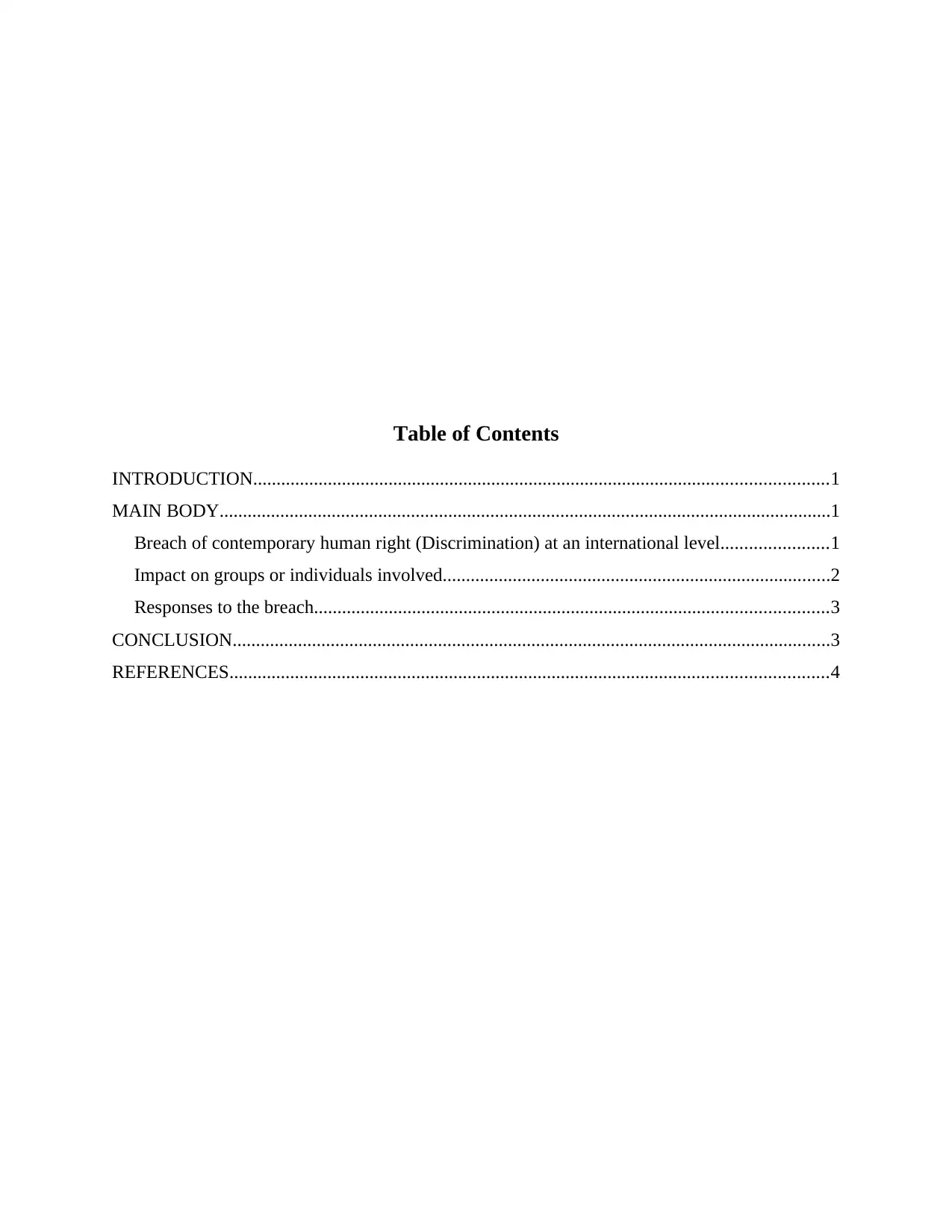
Table of Contents
INTRODUCTION...........................................................................................................................1
MAIN BODY...................................................................................................................................1
Breach of contemporary human right (Discrimination) at an international level.......................1
Impact on groups or individuals involved...................................................................................2
Responses to the breach..............................................................................................................3
CONCLUSION................................................................................................................................3
REFERENCES................................................................................................................................4
INTRODUCTION...........................................................................................................................1
MAIN BODY...................................................................................................................................1
Breach of contemporary human right (Discrimination) at an international level.......................1
Impact on groups or individuals involved...................................................................................2
Responses to the breach..............................................................................................................3
CONCLUSION................................................................................................................................3
REFERENCES................................................................................................................................4
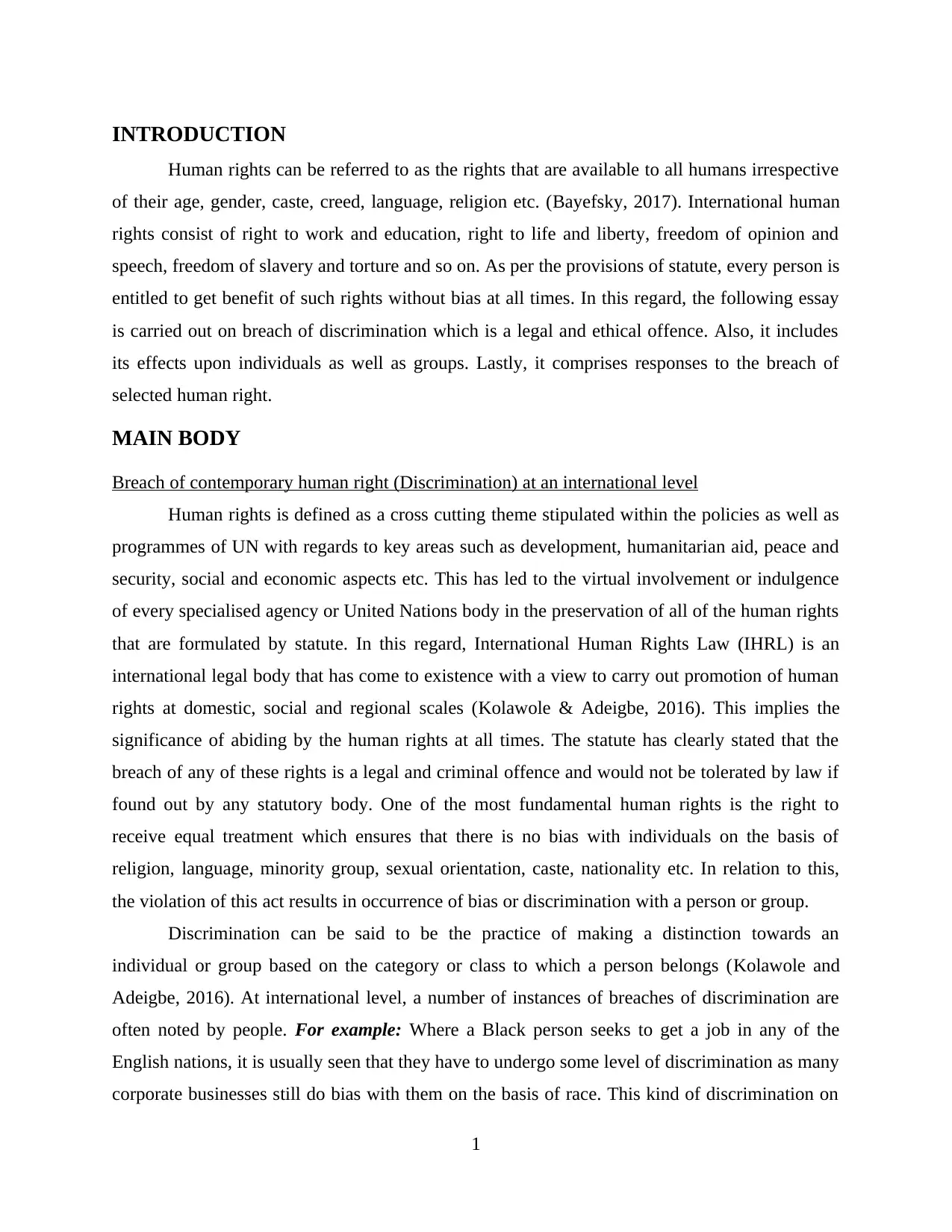
INTRODUCTION
Human rights can be referred to as the rights that are available to all humans irrespective
of their age, gender, caste, creed, language, religion etc. (Bayefsky, 2017). International human
rights consist of right to work and education, right to life and liberty, freedom of opinion and
speech, freedom of slavery and torture and so on. As per the provisions of statute, every person is
entitled to get benefit of such rights without bias at all times. In this regard, the following essay
is carried out on breach of discrimination which is a legal and ethical offence. Also, it includes
its effects upon individuals as well as groups. Lastly, it comprises responses to the breach of
selected human right.
MAIN BODY
Breach of contemporary human right (Discrimination) at an international level
Human rights is defined as a cross cutting theme stipulated within the policies as well as
programmes of UN with regards to key areas such as development, humanitarian aid, peace and
security, social and economic aspects etc. This has led to the virtual involvement or indulgence
of every specialised agency or United Nations body in the preservation of all of the human rights
that are formulated by statute. In this regard, International Human Rights Law (IHRL) is an
international legal body that has come to existence with a view to carry out promotion of human
rights at domestic, social and regional scales (Kolawole & Adeigbe, 2016). This implies the
significance of abiding by the human rights at all times. The statute has clearly stated that the
breach of any of these rights is a legal and criminal offence and would not be tolerated by law if
found out by any statutory body. One of the most fundamental human rights is the right to
receive equal treatment which ensures that there is no bias with individuals on the basis of
religion, language, minority group, sexual orientation, caste, nationality etc. In relation to this,
the violation of this act results in occurrence of bias or discrimination with a person or group.
Discrimination can be said to be the practice of making a distinction towards an
individual or group based on the category or class to which a person belongs (Kolawole and
Adeigbe, 2016). At international level, a number of instances of breaches of discrimination are
often noted by people. For example: Where a Black person seeks to get a job in any of the
English nations, it is usually seen that they have to undergo some level of discrimination as many
corporate businesses still do bias with them on the basis of race. This kind of discrimination on
1
Human rights can be referred to as the rights that are available to all humans irrespective
of their age, gender, caste, creed, language, religion etc. (Bayefsky, 2017). International human
rights consist of right to work and education, right to life and liberty, freedom of opinion and
speech, freedom of slavery and torture and so on. As per the provisions of statute, every person is
entitled to get benefit of such rights without bias at all times. In this regard, the following essay
is carried out on breach of discrimination which is a legal and ethical offence. Also, it includes
its effects upon individuals as well as groups. Lastly, it comprises responses to the breach of
selected human right.
MAIN BODY
Breach of contemporary human right (Discrimination) at an international level
Human rights is defined as a cross cutting theme stipulated within the policies as well as
programmes of UN with regards to key areas such as development, humanitarian aid, peace and
security, social and economic aspects etc. This has led to the virtual involvement or indulgence
of every specialised agency or United Nations body in the preservation of all of the human rights
that are formulated by statute. In this regard, International Human Rights Law (IHRL) is an
international legal body that has come to existence with a view to carry out promotion of human
rights at domestic, social and regional scales (Kolawole & Adeigbe, 2016). This implies the
significance of abiding by the human rights at all times. The statute has clearly stated that the
breach of any of these rights is a legal and criminal offence and would not be tolerated by law if
found out by any statutory body. One of the most fundamental human rights is the right to
receive equal treatment which ensures that there is no bias with individuals on the basis of
religion, language, minority group, sexual orientation, caste, nationality etc. In relation to this,
the violation of this act results in occurrence of bias or discrimination with a person or group.
Discrimination can be said to be the practice of making a distinction towards an
individual or group based on the category or class to which a person belongs (Kolawole and
Adeigbe, 2016). At international level, a number of instances of breaches of discrimination are
often noted by people. For example: Where a Black person seeks to get a job in any of the
English nations, it is usually seen that they have to undergo some level of discrimination as many
corporate businesses still do bias with them on the basis of race. This kind of discrimination on
1
⊘ This is a preview!⊘
Do you want full access?
Subscribe today to unlock all pages.

Trusted by 1+ million students worldwide
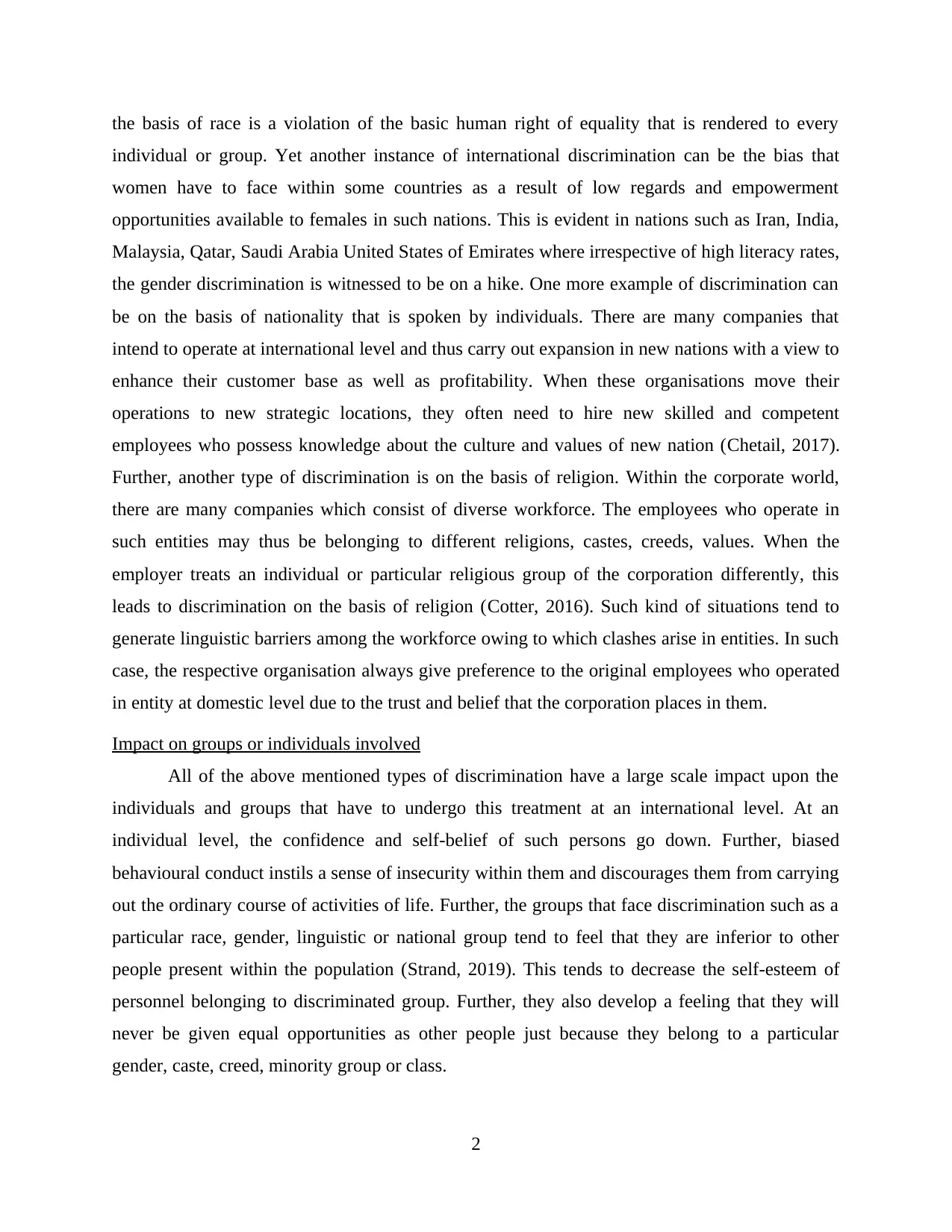
the basis of race is a violation of the basic human right of equality that is rendered to every
individual or group. Yet another instance of international discrimination can be the bias that
women have to face within some countries as a result of low regards and empowerment
opportunities available to females in such nations. This is evident in nations such as Iran, India,
Malaysia, Qatar, Saudi Arabia United States of Emirates where irrespective of high literacy rates,
the gender discrimination is witnessed to be on a hike. One more example of discrimination can
be on the basis of nationality that is spoken by individuals. There are many companies that
intend to operate at international level and thus carry out expansion in new nations with a view to
enhance their customer base as well as profitability. When these organisations move their
operations to new strategic locations, they often need to hire new skilled and competent
employees who possess knowledge about the culture and values of new nation (Chetail, 2017).
Further, another type of discrimination is on the basis of religion. Within the corporate world,
there are many companies which consist of diverse workforce. The employees who operate in
such entities may thus be belonging to different religions, castes, creeds, values. When the
employer treats an individual or particular religious group of the corporation differently, this
leads to discrimination on the basis of religion (Cotter, 2016). Such kind of situations tend to
generate linguistic barriers among the workforce owing to which clashes arise in entities. In such
case, the respective organisation always give preference to the original employees who operated
in entity at domestic level due to the trust and belief that the corporation places in them.
Impact on groups or individuals involved
All of the above mentioned types of discrimination have a large scale impact upon the
individuals and groups that have to undergo this treatment at an international level. At an
individual level, the confidence and self-belief of such persons go down. Further, biased
behavioural conduct instils a sense of insecurity within them and discourages them from carrying
out the ordinary course of activities of life. Further, the groups that face discrimination such as a
particular race, gender, linguistic or national group tend to feel that they are inferior to other
people present within the population (Strand, 2019). This tends to decrease the self-esteem of
personnel belonging to discriminated group. Further, they also develop a feeling that they will
never be given equal opportunities as other people just because they belong to a particular
gender, caste, creed, minority group or class.
2
individual or group. Yet another instance of international discrimination can be the bias that
women have to face within some countries as a result of low regards and empowerment
opportunities available to females in such nations. This is evident in nations such as Iran, India,
Malaysia, Qatar, Saudi Arabia United States of Emirates where irrespective of high literacy rates,
the gender discrimination is witnessed to be on a hike. One more example of discrimination can
be on the basis of nationality that is spoken by individuals. There are many companies that
intend to operate at international level and thus carry out expansion in new nations with a view to
enhance their customer base as well as profitability. When these organisations move their
operations to new strategic locations, they often need to hire new skilled and competent
employees who possess knowledge about the culture and values of new nation (Chetail, 2017).
Further, another type of discrimination is on the basis of religion. Within the corporate world,
there are many companies which consist of diverse workforce. The employees who operate in
such entities may thus be belonging to different religions, castes, creeds, values. When the
employer treats an individual or particular religious group of the corporation differently, this
leads to discrimination on the basis of religion (Cotter, 2016). Such kind of situations tend to
generate linguistic barriers among the workforce owing to which clashes arise in entities. In such
case, the respective organisation always give preference to the original employees who operated
in entity at domestic level due to the trust and belief that the corporation places in them.
Impact on groups or individuals involved
All of the above mentioned types of discrimination have a large scale impact upon the
individuals and groups that have to undergo this treatment at an international level. At an
individual level, the confidence and self-belief of such persons go down. Further, biased
behavioural conduct instils a sense of insecurity within them and discourages them from carrying
out the ordinary course of activities of life. Further, the groups that face discrimination such as a
particular race, gender, linguistic or national group tend to feel that they are inferior to other
people present within the population (Strand, 2019). This tends to decrease the self-esteem of
personnel belonging to discriminated group. Further, they also develop a feeling that they will
never be given equal opportunities as other people just because they belong to a particular
gender, caste, creed, minority group or class.
2
Paraphrase This Document
Need a fresh take? Get an instant paraphrase of this document with our AI Paraphraser
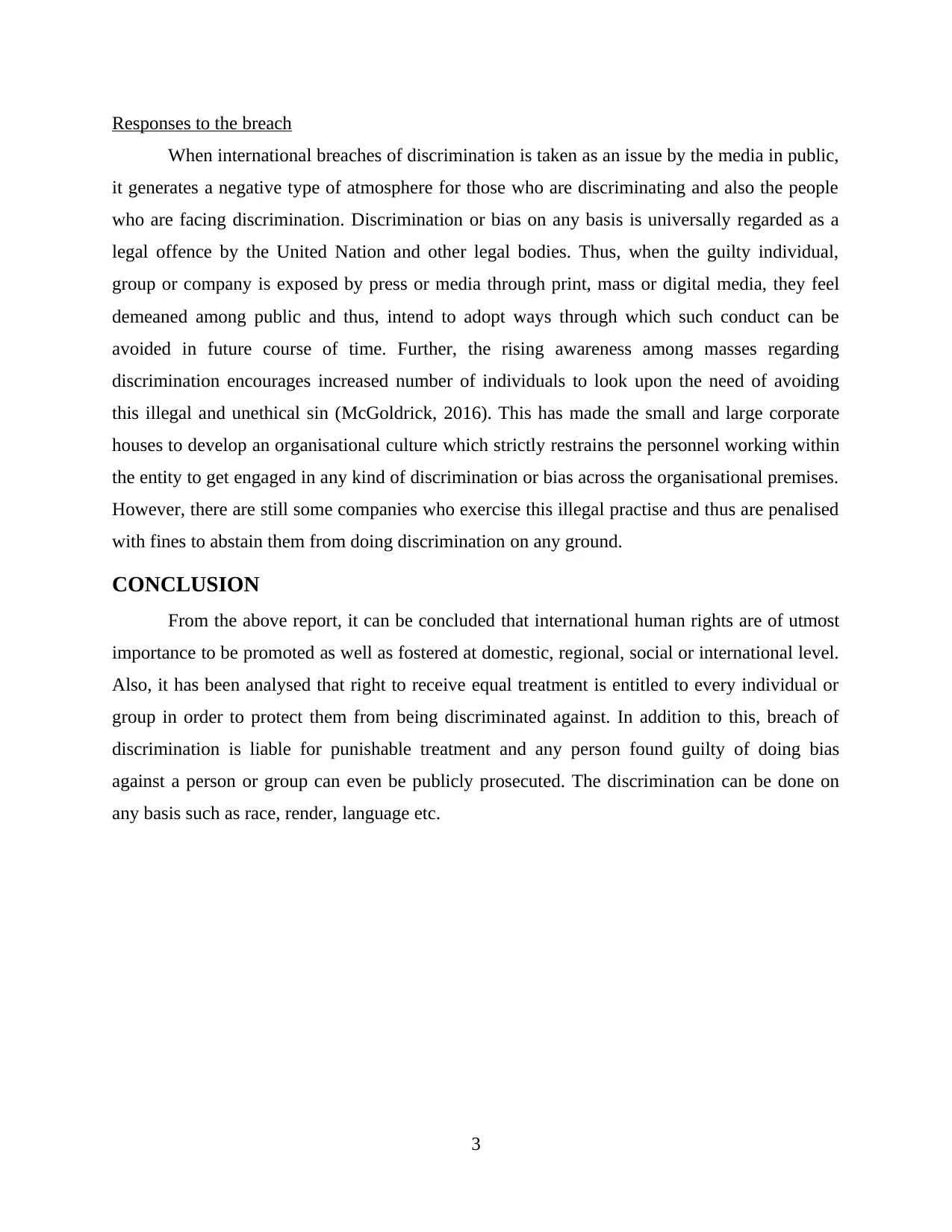
Responses to the breach
When international breaches of discrimination is taken as an issue by the media in public,
it generates a negative type of atmosphere for those who are discriminating and also the people
who are facing discrimination. Discrimination or bias on any basis is universally regarded as a
legal offence by the United Nation and other legal bodies. Thus, when the guilty individual,
group or company is exposed by press or media through print, mass or digital media, they feel
demeaned among public and thus, intend to adopt ways through which such conduct can be
avoided in future course of time. Further, the rising awareness among masses regarding
discrimination encourages increased number of individuals to look upon the need of avoiding
this illegal and unethical sin (McGoldrick, 2016). This has made the small and large corporate
houses to develop an organisational culture which strictly restrains the personnel working within
the entity to get engaged in any kind of discrimination or bias across the organisational premises.
However, there are still some companies who exercise this illegal practise and thus are penalised
with fines to abstain them from doing discrimination on any ground.
CONCLUSION
From the above report, it can be concluded that international human rights are of utmost
importance to be promoted as well as fostered at domestic, regional, social or international level.
Also, it has been analysed that right to receive equal treatment is entitled to every individual or
group in order to protect them from being discriminated against. In addition to this, breach of
discrimination is liable for punishable treatment and any person found guilty of doing bias
against a person or group can even be publicly prosecuted. The discrimination can be done on
any basis such as race, render, language etc.
3
When international breaches of discrimination is taken as an issue by the media in public,
it generates a negative type of atmosphere for those who are discriminating and also the people
who are facing discrimination. Discrimination or bias on any basis is universally regarded as a
legal offence by the United Nation and other legal bodies. Thus, when the guilty individual,
group or company is exposed by press or media through print, mass or digital media, they feel
demeaned among public and thus, intend to adopt ways through which such conduct can be
avoided in future course of time. Further, the rising awareness among masses regarding
discrimination encourages increased number of individuals to look upon the need of avoiding
this illegal and unethical sin (McGoldrick, 2016). This has made the small and large corporate
houses to develop an organisational culture which strictly restrains the personnel working within
the entity to get engaged in any kind of discrimination or bias across the organisational premises.
However, there are still some companies who exercise this illegal practise and thus are penalised
with fines to abstain them from doing discrimination on any ground.
CONCLUSION
From the above report, it can be concluded that international human rights are of utmost
importance to be promoted as well as fostered at domestic, regional, social or international level.
Also, it has been analysed that right to receive equal treatment is entitled to every individual or
group in order to protect them from being discriminated against. In addition to this, breach of
discrimination is liable for punishable treatment and any person found guilty of doing bias
against a person or group can even be publicly prosecuted. The discrimination can be done on
any basis such as race, render, language etc.
3
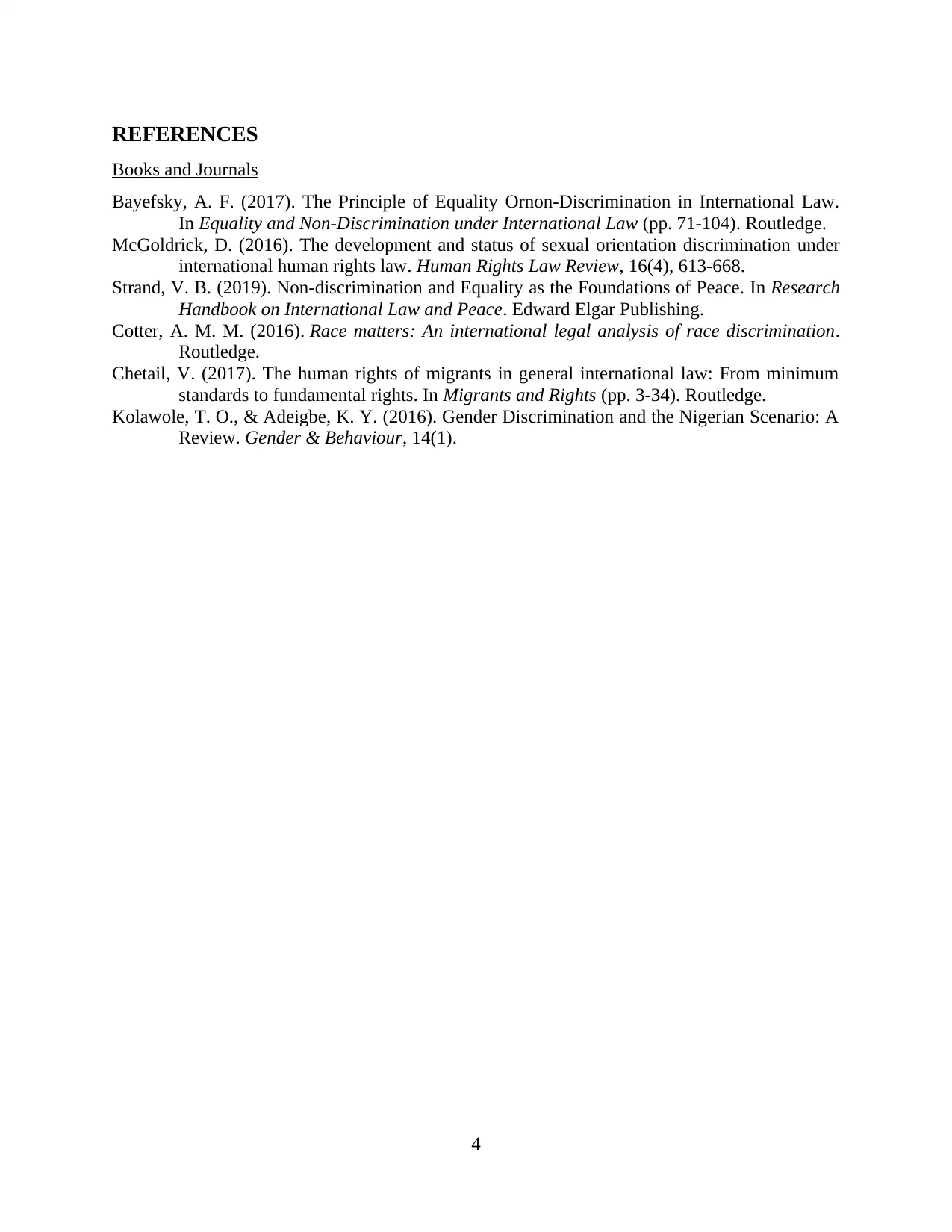
REFERENCES
Books and Journals
Bayefsky, A. F. (2017). The Principle of Equality Ornon-Discrimination in International Law.
In Equality and Non-Discrimination under International Law (pp. 71-104). Routledge.
McGoldrick, D. (2016). The development and status of sexual orientation discrimination under
international human rights law. Human Rights Law Review, 16(4), 613-668.
Strand, V. B. (2019). Non-discrimination and Equality as the Foundations of Peace. In Research
Handbook on International Law and Peace. Edward Elgar Publishing.
Cotter, A. M. M. (2016). Race matters: An international legal analysis of race discrimination.
Routledge.
Chetail, V. (2017). The human rights of migrants in general international law: From minimum
standards to fundamental rights. In Migrants and Rights (pp. 3-34). Routledge.
Kolawole, T. O., & Adeigbe, K. Y. (2016). Gender Discrimination and the Nigerian Scenario: A
Review. Gender & Behaviour, 14(1).
4
Books and Journals
Bayefsky, A. F. (2017). The Principle of Equality Ornon-Discrimination in International Law.
In Equality and Non-Discrimination under International Law (pp. 71-104). Routledge.
McGoldrick, D. (2016). The development and status of sexual orientation discrimination under
international human rights law. Human Rights Law Review, 16(4), 613-668.
Strand, V. B. (2019). Non-discrimination and Equality as the Foundations of Peace. In Research
Handbook on International Law and Peace. Edward Elgar Publishing.
Cotter, A. M. M. (2016). Race matters: An international legal analysis of race discrimination.
Routledge.
Chetail, V. (2017). The human rights of migrants in general international law: From minimum
standards to fundamental rights. In Migrants and Rights (pp. 3-34). Routledge.
Kolawole, T. O., & Adeigbe, K. Y. (2016). Gender Discrimination and the Nigerian Scenario: A
Review. Gender & Behaviour, 14(1).
4
⊘ This is a preview!⊘
Do you want full access?
Subscribe today to unlock all pages.

Trusted by 1+ million students worldwide
1 out of 6
Related Documents
Your All-in-One AI-Powered Toolkit for Academic Success.
+13062052269
info@desklib.com
Available 24*7 on WhatsApp / Email
![[object Object]](/_next/static/media/star-bottom.7253800d.svg)
Unlock your academic potential
Copyright © 2020–2025 A2Z Services. All Rights Reserved. Developed and managed by ZUCOL.





